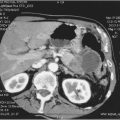Introduction
Diabetic neuropathies (DNs) encompass a wide range of nerve abnormalities and prevalence rates reported are between 5 and 100%, depending on diagnostic criteria used.1–3 DNs affect both peripheral and autonomic nervous systems and cause considerable morbidity and mortality in both type I and type II diabetic patients. DNs account for more hospitalizations than all other diabetic complications combined and are responsible for 50–75% of non-traumatic amputations.4, 5 In older adults who have diabetes, peripheral neuropathies (PNs) are especially troublesome because of their detrimental effects on stability, sensorimotor function, gait and activities of daily living (ADLs).6–8 The incidence of distal symmetric neuropathy rises dramatically with increasing age after 65 years in both diabetic and non-diabetic men and women, with a higher incidence among older adults with diabetes (32.2, 95% CI 21.7–42.7 versus 5.8, 95% CI 4.3–7.8, per 1000 person-years).9 Diabetes accounted for 39% of prevalent and 49% of incident cases of neuropathy in older adults,9 emphasizing diabetes as a critical although not sole risk factor. In the USA for 1999–2000, 28% of adults aged 70–79 years and 35% of adults aged >80 years had PN, based on a simple screen for reduced sensation at the foot.10 In this chapter, we present and discuss the most recent approaches to the treatment of the common forms of diabetic neuropathy, including symmetric, focal and diffuse neuropathies (Box 65.1, Figure 65.1). We also provide the reader with algorithms for the recognition and management of common pain and entrapment syndromes and a global approach to the recognition of syndromes requiring specialized treatments based upon our improved understanding of their aetiopathogenesis. A comprehensive evaluation of autonomic neuropathy is beyond the scope of this chapter, but the reader is referred to two excellent reviews on this topic.11, 12.
- Mononeuritis
- Entrapment syndromes
- Proximal motor (amyotrophy)
- Coexisting chronic inflammatory demyelinating polyneuropathy (CIPD)
- Monoclonal gammopathy of undetermined significance (MGUS)
- Circulating GM1 antibodies and antibodies to neuronal cells
- Inflammatory vasculitis
- Coexisting chronic inflammatory demyelinating polyneuropathy (CIPD)
- Acute sensory
- Autonomic
- Chronic sensorimotor distal polyneuropathy (DPN)
- Large fibre
- Small fibre
- Large fibre
Figure 65.1 Schematic representation of different clinical presentations of diabetic neuropathy. Reprinted from Vinik et al., Medical Clinics of North America 2004;88:947–99. Copyright 2004, with permission from Elsevier.
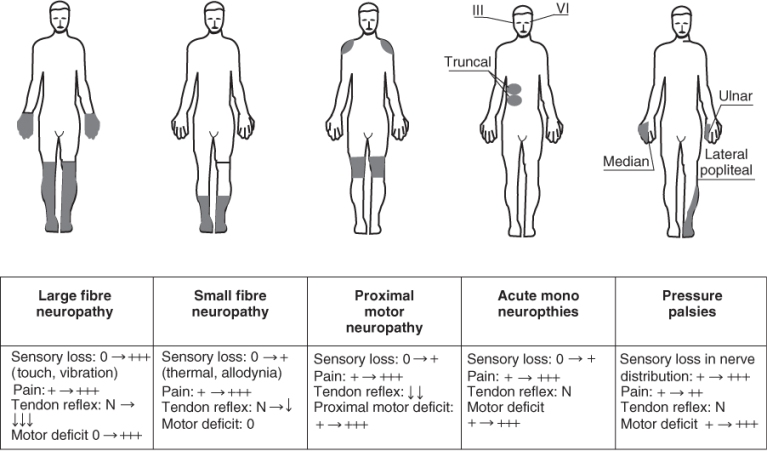
Pathogenic Mechanisms
Figure 65.2 shows our current view on the pathogenesis of DPN. The aetiology includes metabolic; vascular; autoimmune; oxidative and nitrosative stress; and neurohormonal growth factor deficiency. Inflammation is more clearly involved in the specific inflammatory neuropathies such as vasculitic and granulomatous disease than in DPN per se,13 although this has not been studied in age-related neuropathies. P- and E-selectin and VCAM-1 activated during the inflammatory process predict the decline in peripheral nerve function among diabetic patients.14 Impaired blood flow and endoneurial microvasculopathy, mainly thickening of the blood vessel wall or occlusion, play a critical role. Metabolic disturbances in the presence of an underlying genetic predisposition cause reduced nerve perfusion. Both animal and human studies have shown major defects arising from chronic hyperglycaemia and altered lipid metabolism.15 Oxidative/nitrosative stress-related mechanisms are also important in vascular dysfunction and tend to increase vasoconstriction. Improving nerve blood flow may improve nerve conduction velocity in DPN.16 Oxidative and nitrosative stress and inflammation are implicated in several neurodegenerative disorders, including Alzheimer’s disease and amyotrophic lateral sclerosis (ALS),17 and in DPN.18, 19 Potentially, similar mechanisms play a role in the peripheral nerve with ageing. As ageing20 and type 2 diabetes21–25 are associated with increased levels of subclinical systemic inflammatory markers, such as cytokines IL-6 and TNF-α, and acute-phase proteins such as CRP. An Italian population-based study found that high levels of sIL-6R and lower vitamin E were significantly related to lower nerve conduction velocity.26
Figure 65.2 Pathogenesis of diabetic neuropathies based upon autoimmunity, metabolic and microvascular insufficiency.121 Ab, antibody; AGE, advance glycation end products; C′, complement; DAG, diacylglycerol; ET, endothelin; EDHF, endothelium-derived hyperpolarizing factor; GF, growth factor; IGF; insulin-like growth factor; NFkB, nuclear factor κB; NGF, nerve growth factor; NO, nitric oxide; NT3, neurotropin 3; PKC, protein kinase C; PGI2, prostaglandin I2; ROS, reactive oxygen species; TRK, tyrosine kinase.
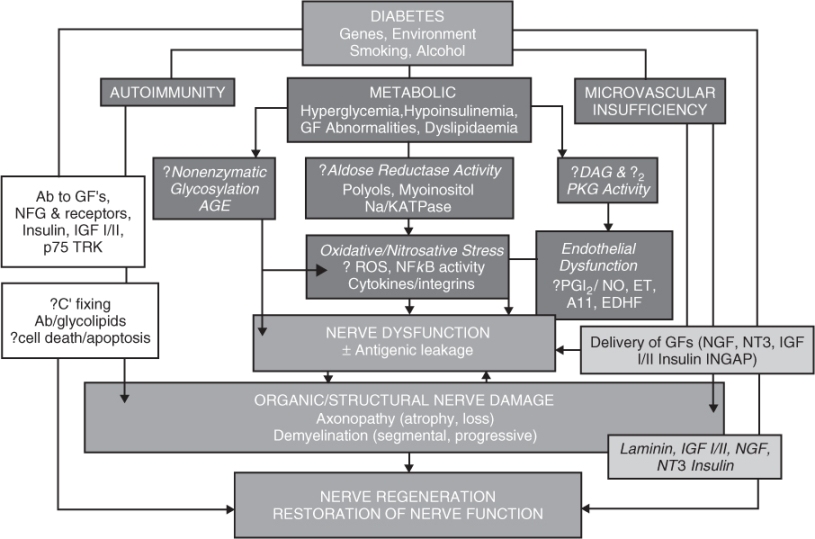
Clinical Presentation and Diagnosis
Focal Neuropathies (Mononeuropathies and Entrapment Syndromes)
Mononeuropathies occur primarily in older adults. Their onset is generally acute and associated with pain and they heal spontaneously, usually within 6–8 weeks. These neuropathies are caused by vascular obstruction, typically in the cranial nerves III, VI and VII, ulnar, median and peroneal. Mononeuropathies must be distinguished from entrapment syndromes, which start slowly, progress and persist without intervention (Table 65.1).
Table 65.1 Comparison of features of mononeuropathies, entrapment syndromes and distal symmetrical polyneuropathy.
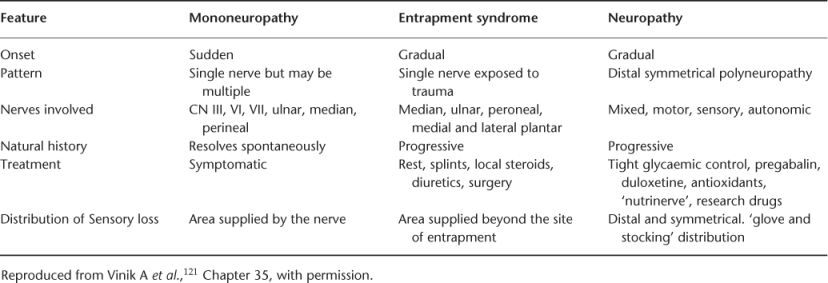
Common entrapment sites in diabetic patients involve the median, ulnar and peroneal nerves, the lateral cutaneous nerve of the thigh and the tibial nerve in the tarsal canal. Their onset is gradual and is usually limited to a single nerve.27 Carpal tunnel syndrome is the most common entrapment syndrome, affecting one in three diabetic patients.28 It occurs three times more frequently in patients with diabetes compared with the normal healthy population29 and may be related to diabetic cheiroarthropathy, repeated undetected trauma, metabolic changes or an accumulation of fluid or oedema within the confined space of the carpal tunnel.30 Surgical treatment of entrapment syndrome neuropathies is effective, but the decision to proceed with surgery should be based on severity of symptoms, appearance of motor weakness and failure of non-surgical treatment, and there must be electrophysiological evidence of nerve entrapment.
Diffuse Neuropathies (Proximal Motor Neuropathies)
Proximal motor neuropathy can be clinically identified based on proximal muscle weakness and muscle wasting. It may be symmetric or asymmetric in distribution and is sometimes associated with pain in the lateral aspect of the thigh. Patients usually present with weakness of the iliopsoas, obturator and adductor muscles, together with relative preservation of the gluteus maximus and minimus and hamstrings.31, 32 Those affected have great difficulty rising out of a chair unaided, although heel or toe standing is surprisingly good. In the classic form of diabetic proximal motor neuropathy, axonal loss is the predominant process and the condition coexists with distal symmetric polyneuropathy.33 Electrophysiological evaluation reveals lumbosacral plexopathy.34 Common features include the following:
- Primarily affects the elderly.
- Onset may be gradual or acute.
- Begins with pain in the thighs and hips or buttocks.
- Pain followed by significant weakness of the proximal muscles of the lower limbs with inability to rise from a sitting position (positive Gower’s manoeuvre).
- Begins unilaterally and spreads bilaterally.
- Coexists with DPN.
- Spontaneous muscle fasciculation or provoked by percussion.
Proximal motor neuropathy is now recognized as being secondary to a variety of causes unrelated to diabetes, but which occur more frequently in patients who have diabetes than in the general population. It includes patients who have CIDP, MGUS, circulating GM1 antibodies and antibodies to neuronal cells and inflammatory vasculitis.35, 36 Vinik37 found that almost half of patients with proximal neuropathies have a vasculitis and all but 9% have CIDP, MGUS or a ganglioside antibody syndrome.37, 38 Sharma et al.39 examined over 1000 patients who had neurological disorders and found that CIDP was 11 times more frequent among diabetic than non-diabetic patients.
In contrast, if demyelination predominates and the motor deficit affects proximal and distal muscle groups, the diagnosis of CIDP should be considered. It is important to divide proximal syndromes into these two subcategories because the CIDP variant responds dramatically to intervention,37, 39, 40 with IVIG, plasmapheresis, steroids and immunosuppressive agents,37 whereas proximal motor neuropathy runs its own course over months to years. Until more evidence is available, we consider them as separate syndromes.
These conditions should be distinguished from spinal stenosis syndromes common in older individuals, which occur because of (1) encroachment on nerve roots as they emerge from the spinal cord, (2) osteophytes that narrow joint space and cause compression, (3) hypertrophy of the ligamentum flavum by ageing, (4) disk dehydration due to ageing and (5) arachnoiditis. If compression occurs at the level of T12 and L1/2, the vascular system may be involved. This often causes claudication during downhill walking and is relieved with spinal flexion. Nerve root compression is more typical at L5/S1 and therefore in difficult cases it may be necessary to obtain an MRI of the lumbosacral spine. Diagnosis is critical because therapy may range from simple physical therapy to surgical decompression if symptoms are severe or if motor paralysis exists.
Chronic Sensorimotor Distal Polyneuropathy
Chronic sensorimotor DPN is the most common and widely recognized form of diabetic neuropathy. The onset is usually insidious, following stress or initiation of therapy for diabetes. DPN may be either sensory or motor and may involve small fibres, large fibres or both.41 Initial neurological evaluation should focus on detection of the specific part of the nervous system affected by diabetes. Most patients with DPN have a combination of both large and small nerve fibre involvement (Figure 65.3).
Figure 65.3 Schematic presentation of the physiological function of different nerve fibres.121 Aα fibres are large myelinated fibres, in charge of motor functions and muscle control. Aα/β fibres are also large myelinated fibres, with sensory functions such as perception to touch, vibration and position. Aδ fibres are small myelinated fibres, in charge of pain stimuli and cold perception. C fibres can be myelinated or unmyelinated and have both sensory (warm perception and pain) and autonomic functions (blood pressure and heart rate regulation, sweating, etc.). GIT, gastrointestinal tract; GUT, genitourinary tract.
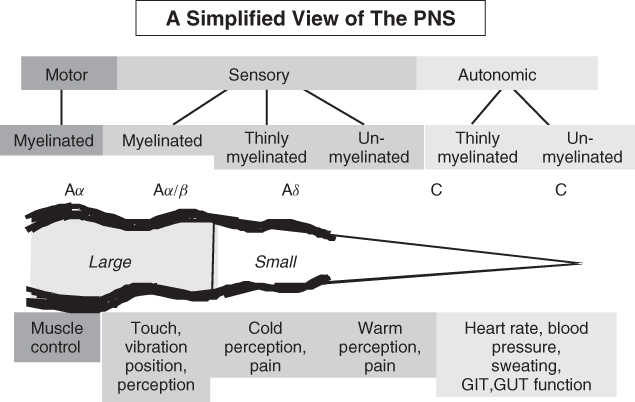
Large Fibre Neuropathies
A majority of neuropathies in older adults involve large fibres. Large fibre neuropathies may involve sensory and/or motor nerves and most patients will present with a ‘glove and stocking’ distribution of sensory loss.42 These tend to be the neuropathies of signs rather than symptoms. They are manifested by reduced vibration (often the first objective evidence of neuropathy) and position sense, weakness, muscle wasting and depressed tendon reflexes. Early in the course of the neuropathic process, multifocal sensory loss might also be found (Table 65.2) The symptoms may be minimal, such as a sensation of walking on cotton, floors feeling ‘strange’, inability to turn the pages of a book or inability to discriminate among coins. In some patients, severe distal muscle weakness can accompany the sensory loss, resulting in an inability to stand on the toes or heels.
Table 65.2 Decline in neurological function between 20 and 80 years of age.
| Function | Dysfunction (%) |
| Vibratory sensation | 97 |
| Stability (rombergism) | 32 |
| Handwriting speed | 30 |
| Handgrip strength | 22 |
| Ankle jerk | 9 |
| Ataxia (finger–nose test) | 8 |
| Pain perception | 0 |
Data from references 118–120.
Little is known, however, at the clinical and population levels about the role of age-related loss in peripheral nerve function to sarcopenia and loss of strength associated with ageing. Loss of lean mass, or sarcopenia, is thought to account for much of the loss of strength and function in older adults.43, 44 In addition to lower mass, ageing muscle is characterized by loss of muscle fibres, predominantly type 2 fast-twitch fibres and an increase in grouping or ‘clustering’ of type 1 fibres.45 These changes are thought to be caused in part by disuse atrophy and in part to drop out of the anterior horn motor neurons at the level of the spinal cord. When the motor neuron is lost with disease (polio, ALS) or ageing, remaining motor neurons can sprout new dendritic connections to ‘orphaned’ muscle fibres. This reinnervation process may be responsible for the increase in grouping of type 1 fibres and may limit regaining type 2 fibres after loss caused by atrophy. Although the innervation of muscle tissue is essential to its function, very little is known about the relative contribution of peripheral nerve function to muscle function and functional decline in community-dwelling older adults. In diabetes, severe PN is clearly related to muscle atrophy.46 Recent work in epidemiological cohort studies of older adults indicates that poorer motor nerve function is related to lower calf muscle density47 and poorer sensory and motor nerve function is related to lower quadriceps and ankle strength, independent of diabetes and peripheral arterial disease status.48 Given the known atrophy and denervation in the pathophysiological description of muscle ageing, it is remarkable how little is known at the clinical and population levels about the role of age-related loss in nerve function to the age-related loss of muscle mass and strength. This neurogenic process may be a critical link in the pathogenesis of sarcopenia and mobility loss in old age.
Older adults who have large fibre neuropathies have difficulty stabilizing their bodies when walking on irregular surfaces, with concomitant impairment of reaction time and balance.6 This lack of peripheral sensory input increases the risk of falling and fracture in these patients. In the Women’s Health and Ageing study, women with diabetes reported difficulty in performing 14 of 15 daily tasks, which included walking two to three blocks, lifting 10 pounds, using a telephone and bathing.7 Failure to perform basic ADLs readily compromises an individual’s independence and quality of life (QOL), which increases mortality and morbidity in this susceptible population.49 The Norfolk QOL tool is used to measure patients’ perception of the effects of diabetes and diabetic neuropathy.49
Epidemiological studies have found that older adults with poor peripheral nerve function have worse physical performance, balance, muscle density and bone density.22, 23, 47, 50, 51 Most of these associations were independent of diabetes status. A twofold higher prospective decline in motor performance exists for older adults who have distal symmetrical neuropathy.52 Older women with PN have significantly greater step width:length ratio and step-time variability, less efficient gait and lower gait speed compared with controls.8, 53 Clinical consequences of higher fall and fracture rates are also evident in older adults who have peripheral nerve impairments.54–58
In recent years, several inexpensive devices have been developed for the assessment of somatosensory function, including vibration, thermal energy and light-touch perception. These instruments allow for the non-invasive assessment of cutaneous sensory functions, which correlate with specific neural fibre function. In addition to the above modalities, quantitative sensory tests (QSTs) are available for the assessment of pain threshold and cutaneous current perception.41 Clinical manifestations of large fibre neuropathies include the following:
- impaired vibration perception and position sense;
- depressed tendon reflexes;
- dull (like a toothache), crushing or cramp-like pain in the bones of the feet;
- sensory ataxia (waddling like a duck);
- wasting of small muscles of feet with hammertoes and weakness of hands and feet;
- shortening of the Achilles tendon with equinus;
- increased blood flow to the foot (hot foot) with increased risk of Charcot neuroarthropathy.
Small Fibre Neuropathies
Small nerve fibre dysfunction usually occurs early and is often present without objective signs or electrophysiological evidence of nerve damage.41 It manifests first in the lower limbs with symptoms of pain and hyperalgesia, followed by a loss of thermal sensitivity and reduced light-touch and pinprick sensation.59 Small unmyelinated C-fibres control pain sensation, warm thermal perception and autonomic function. A patient who has early damage to these nerves may experience burning, dysesthetic pain, often accompanied by hyperalgesia, and allodynia. This pain is distinct from that of large fibre neuropathy, in which the pain is usually described as deep and ‘gnawing’. Because peripheral sympathetic nerve fibres are also comprised of small, unmyelinated C-fibres, it is not surprising that pain is improved with sympathetic blocking agents (e.g. beta-blockers, calcium channel blockers).
It should be noted that dry, cracked skin and impaired skin blood flow in the feet, together with impaired sympathetic regulation of sweat glands and anteriovenous (AV) shunt vessels in the feet, create a favourable environment for bacteria. In the absence of pain, which occurs with the depletion of substance P, patients may be led to believe that their neuropathy has subsided, when in fact it is progressing. These patients may also display decreased thermal pain thresholds, which may be caused in part by the decrease in nerve growth factor (NGF) that maintains small fibre neurons. The clinical manifestations of small fibre neuropathies can be summarized as follows:
- prominent pain: burning and superficial and associated with allodynia; i.e. interpretation of all stimuli as painful (e.g. touch);
- hypoalgesia late in the condition;
- defective autonomic function with decreased sweating, dry skin, impaired vasomotion and blood flow and cold feet;
- intact reflexes, motor strength;
- silent electrophysiology;
- absence of objective signs reduced sensitivity to 1.0 g Semmes–Weinstein monofilament and pricking sensation using the Waardenberg wheel or similar instrument;
- as the condition progresses, abnormal thresholds for warm thermal perception, neurovascular function, pain, quantitative sudorimetry and quantitative autonomic function tests;
- increased risk of foot ulceration and subsequent gangrene.
Differential Diagnosis
Diabetes as the cause of neuropathy is diagnosed by exclusion of various other causes of neuropathy. In those patients who have diabetes and neuropathy who present with symptoms of distal symmetric sensorimotor deficit, differential diagnosis should include hereditary sensory neuropathies, vitamin B12 and folate deficiency, syphilis, Lyme disease, neuropathy associated with IgM monoclonal gammopathy of undetermined significance (IgM MGUS neuropathy), other paraneoplastic conditions, autoimmune diseases and toxic neuropathies. In patients who have one or more motor neurological syndromes, chronic motor neuropathies, acute inflammatory demyelinating polyneuropathy (AIDP), CIDP and immunoglobulin G (IgG) and IgA MGUS neuropathies should actively be sought (Table 65.3).
Table 65.3 Differential diagnosis of distal symmetric polyneuropathy.
| Type | Syndrome |
| Congenital/familial | Charcot–Marie–Tooth |
| Traumatic | Entrapment syndromes |
| Inflammatory | Sarcoidosis |
| Leprosy | |
| Lyme disease | |
| HIV | |
| Neoplastic | Carcinoma—paraneoplastic syndromes |
| Myeloma, amyloid | |
| Reticuloses, leukaemias, lymphomas | |
| Metabolic/endocrine | Diabetes mellitus |
| Uraemia | |
| Pernicious anaemia (vitamin B12 deficiency) | |
| Hypothyroidism | |
| Porphyria (acute intermittent) | |
| Vascular | Diabetes, vasculitis |
| Toxic | Alcohol |
| Heavy metals (lead, mercury, arsenic) | |
| Hydrocarbons, chemotherapeutic drugs | |
| Autoimmune | Diabetes |
| PLA syndrome | |
| Chronic inflammatory demyelinating neuropathy | |
| Multifocal motor neuropathy | |
| Guillain–Barré syndrome |
Recent evidence supports an autoimmune aetiology for neuropathy in AIDS, Lyme disease, AIDP, CIDP, multifocal motor neuropathy, MGUS neuropathies and even diabetic polyneuropathy.30, 42 Hence an intensive workup for humoral immune mechanisms should be performed. If any of these conditions are found, the appropriate therapeutic regime for the specific disease must be instituted before embarking on a regime of diabetic neuropathy management. It is not always possible to determine the exact cause of neuropathy if monoclonal gammopathy and diabetes coexist in the same patient. A course of intravenous (i.v.) immunoglobulin or immunosuppression should be attempted, depending on the class of monoclonal antibody.
Nerve tissue biopsy may be helpful for excluding other causes of neuropathy and in the determination of predominant pathological changes in patients who have complex clinical findings as a means of dictating choice of treatment.40, 60 The authors’ laboratory performs nerve biopsies only when non-invasive neurological procedures fail to provide an answer or when extensive evaluation is necessary for scientific purposes.60 We expect a further increase in our dependence on histopathological and ultrastructural examination of nerve tissue for differentiation of neuropathic syndromes as our knowledge of pathophysiological and clinical complexity among diabetic neuropathic variants increases. Figure 65.4 depicts a diagnostic algorithm for the assessment of neurological deficit and classification of neuropathic syndromes.
Figure 65.4 Diagnostic algorithm for assessment of neurological deficit and classification of neuropathic syndrome.1 NSS, neurological symptom score; NDS, nerve disability score; QST, quantitative sensory test; QAFT, quantitative autonomic function test; EMG, electromyography; NCV, nerve conduction velocity.
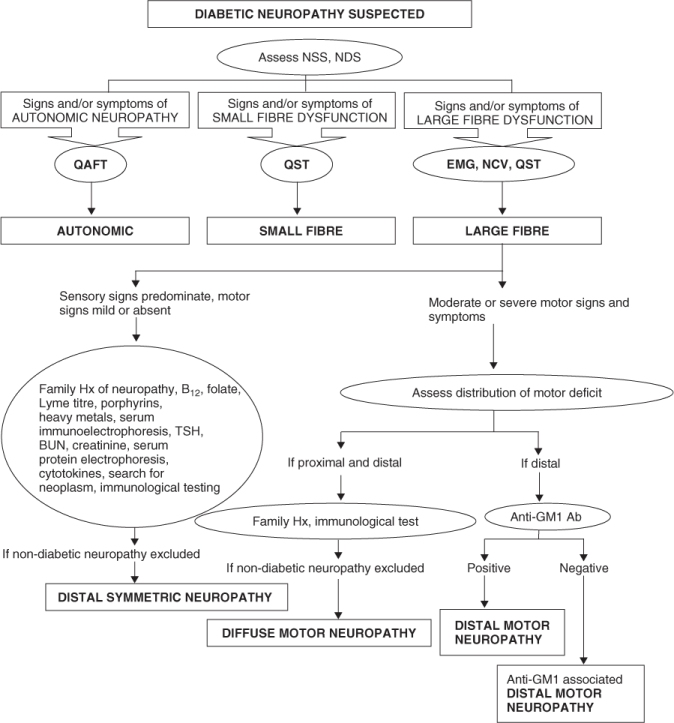
Charcot Neuroarthropathy
Stay updated, free articles. Join our Telegram channel

Full access? Get Clinical Tree






